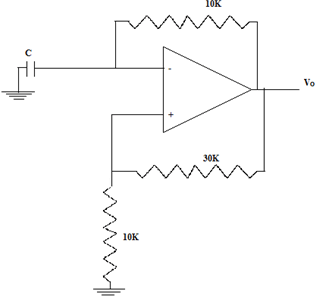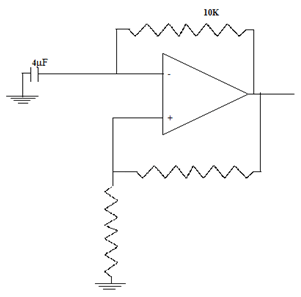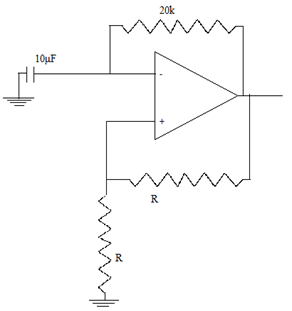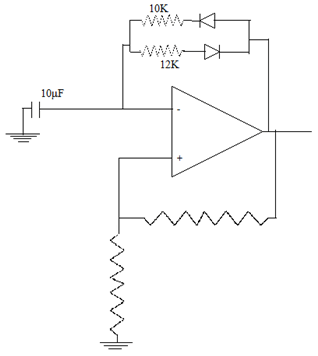This set of Analog Circuits Multiple Choice Questions & Answers (MCQs) focuses on “Different Types of Multivibrators – 1”.
1. What is a square wave generator?
a) Flip-flop
b) Bi-stable multivibrator
c) Astable multivibrator
d) Monostable multivibrator
View Answer
Explanation: An astable multivibrator is one which does not have any stable state. It has two quasi-stable output states which keep toggling at regular intervals. The output waveform is thus a square wave and this circuit is also called a square wave generator or a free running oscillator.
2. Given the circuit below, find the feedback factor.

a) 3
b) 1/3
c) 4
d) 1/4
View Answer
Explanation: The feedback factor is β = R1/R1+R2
β = 10k/30k+10k = 1/4.
3. In an astable multivibrator using an op-amp, the feedback factor is 0.5 and the supply voltage is ±12V. What are the quasi-stable output state and the input to the non-inverting terminal?
a) Quasi-stable output = ±12V, Input to non inverting terminal = ±12V
b) Quasi-stable output = ±6V, Input to non inverting terminal = ±12V
c) Quasi-stable output = ±12V, Input to non inverting terminal = ±6V
d) Quasi-stable output = ±12V, Input to non inverting terminal = 0V
View Answer
Explanation: Quasi-stable output = ±VSat = ± VSupply = ±12V
Input to non inverting terminal = ±βVSat = ±6V.
4. What is the duty cycle of the output of an astable multivibrator?
a) 50%
b) 100%
c) 75%
d) 55%
View Answer
Explanation: An astable multivibrator is a square wave generator. Charging and discharging times of the capacitor are equal and thus the output waveform has a duty cycle of 50%.
5. Given that the feedback factor of an astable multivibrator is 0.3, find the frequency of the output.

a) 22Hz
b) 20kHz
c) 20Hz
d) 40Hz
View Answer
Explanation: TO = 2RCln (1 + β/1-β) = 2RCln(1.3/0.7) = 2x10x4x10-3x0.619 = 49.52ms
f = 1/TO = 20Hz.
6. Consider the following circuit and find the time period of the output of the multivibrator.

a) 0.436 ms
b) 0.436 seconds
c) .5 ms
d) 5.22 seconds
View Answer
Explanation: Since the two feedback resistors are same, then β=0.5.
Thus time period TO = 2RCln3 = 2x20x10x10-3x1.09 = 436ms = 0.436 seconds.
7. How can the duty cycle be changed for an astable multivibrator?
a) By adding another capacitor to the circuit
b) By adding diodes to the circuit
c) By adding an inductor to the circuit
d) The duty cycle cannot be changed
View Answer
Explanation: To generate a square wave of duty cycle other than 50%, diodes can be connected so that charging and discharging now occurs through these diodes. This thus changes the time period as well as the duty cycle of the diodes.
8. Given that the feedback factor is 0.6, find the time period of the circuit below.

a) 0.331 seconds
b) 0.303 seconds
c) 0.276 seconds
d) 0.606 seconds
View Answer
Explanation: T = (RXC + RYC)ln(1+β/1-β)
T = 22x10x10-3xln(1.6/0.4) = 22x10x10-3x1.38 = 0.303 seconds.
9. The monostable multivibrator has one quasi-stable state and one unknown state.
a) True
b) False
View Answer
Explanation: The monostable multivibrator is a circuit whose output has one stable state and one quasi-stable state. If the trigger input is not applied then output remains in the stable state indefinitely and whenever the trigger is applied, the output enters the quasi-stable state. The output then changes back to the stable state on its own after a short duration.
10. Which of these is not a type of monostable multivibrator?
a) Schmitt trigger as a monostable multivibrator
b) Emitter coupled monostable multivibrator
c) Using an op-amp
d) 555 Timer as a monostable multivibrator
View Answer
Explanation: A Schmitt trigger circuit is a comparator circuit, also called a regenerative comparator. It converts any waveform into a square wave. It is not a monostable multivibrator, unlike the other three options.
Sanfoundry Global Education & Learning Series – Analog Circuits.
To practice all areas of Analog Circuits, here is complete set of 1000+ Multiple Choice Questions and Answers.
If you find a mistake in question / option / answer, kindly take a screenshot and email to [email protected]
- Check Electrical & Electronics Engineering Books
- Check Analog Electronics Books
- Apply for Electrical & Electronics Engineering Internship
- Practice Electrical Engineering MCQs
- Apply for Electrical Engineering Internship
